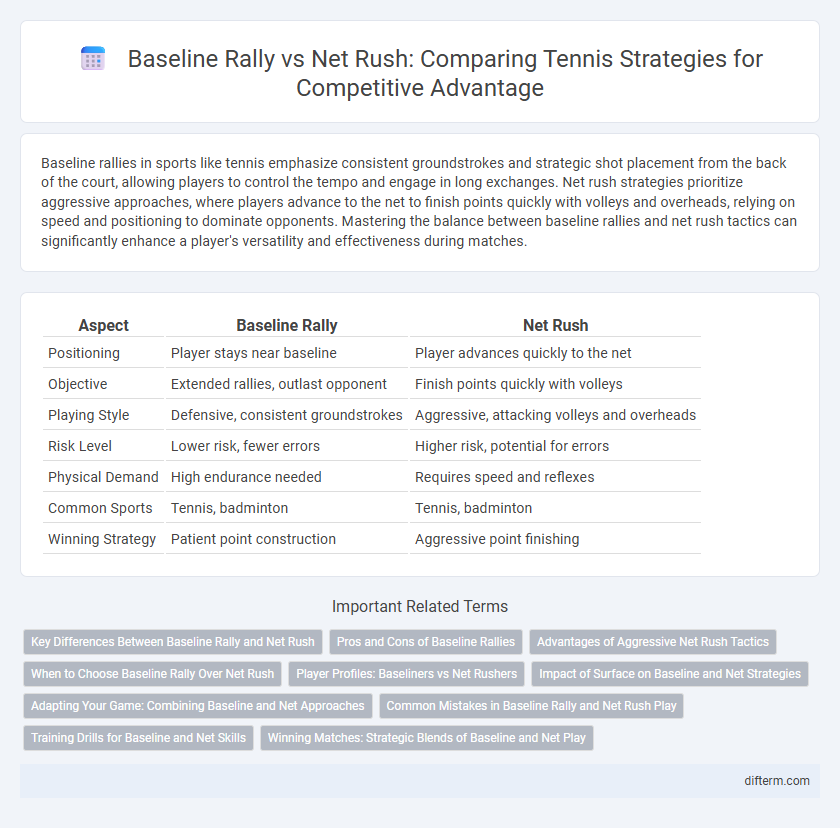Baseline rallies in sports like tennis emphasize consistent groundstrokes and strategic shot placement from the back of the court, allowing players to control the tempo and engage in long exchanges. Net rush strategies prioritize aggressive approaches, where players advance to the net to finish points quickly with volleys and overheads, relying on speed and positioning to dominate opponents. Mastering the balance between baseline rallies and net rush tactics can significantly enhance a player's versatility and effectiveness during matches.
Table of Comparison
| Aspect | Baseline Rally | Net Rush |
|---|---|---|
| Positioning | Player stays near baseline | Player advances quickly to the net |
| Objective | Extended rallies, outlast opponent | Finish points quickly with volleys |
| Playing Style | Defensive, consistent groundstrokes | Aggressive, attacking volleys and overheads |
| Risk Level | Lower risk, fewer errors | Higher risk, potential for errors |
| Physical Demand | High endurance needed | Requires speed and reflexes |
| Common Sports | Tennis, badminton | Tennis, badminton |
| Winning Strategy | Patient point construction | Aggressive point finishing |
Key Differences Between Baseline Rally and Net Rush
Baseline rallies emphasize consistent groundstrokes from the back of the court, prioritizing endurance, precise shot placement, and strategic patience. Net rush tactics focus on aggressive positioning, quick reflexes, and volley skills to shorten points by approaching the net rapidly. The primary difference lies in the baseline rally's reliance on long exchanges versus the net rush's emphasis on offensive, close-range play to control the point.
Pros and Cons of Baseline Rallies
Baseline rallies in sports like tennis offer extended play, allowing players to control the game's pace and strategically wear down opponents with consistent groundstrokes. The downside includes greater physical exertion and vulnerability to aggressive net rush tactics, which can disrupt baseline dominance. Mastery of baseline rallies requires strong stamina and precision, but risks conceding points when facing skilled net rushers who capitalize on shorter exchanges.
Advantages of Aggressive Net Rush Tactics
Aggressive net rush tactics in tennis put immediate pressure on opponents, forcing quicker shot decisions and often resulting in weak returns. By dominating the net, players increase the chances of hitting winning volleys and reduce the opponent's reaction time, leveraging positioning advantage. This approach also disrupts baseline rallies, breaking the rhythm of defensive players and creating more opportunities for decisive points.
When to Choose Baseline Rally Over Net Rush
Choosing a baseline rally over a net rush is ideal when facing opponents with strong volleys or quick reflexes at the net. Baseline rallies exploit an opponent's weaker groundstrokes and reduce risk of being passed by forcing longer exchanges. Players benefit from baseline play when confident in groundstroke consistency and stamina to outlast opponents in extended rallies.
Player Profiles: Baseliners vs Net Rushers
Baseliners excel in consistency and stamina, often relying on powerful groundstrokes to control baseline rallies and outlast opponents in extended exchanges. Net rushers demonstrate agility, quick reflexes, and tactical prowess, using aggressive volleys and approach shots to shorten points and pressure opponents at the net. Player profiles highlight baseliners' endurance and precision contrasted with net rushers' speed, anticipation, and volleying skills, shaping distinct strategic approaches in tennis.
Impact of Surface on Baseline and Net Strategies
Hard courts favor baseline rallies due to their consistent bounce and moderate speed, allowing players to execute powerful groundstrokes with precision. Grass surfaces expedite net rush strategies because the ball skids low and fast, rewarding quick reflexes and short points. Clay courts slow down the ball, enhancing baseline endurance and stamina while making net approaches riskier due to higher bounce and reduced speed.
Adapting Your Game: Combining Baseline and Net Approaches
Combining baseline rallies and net rush tactics enhances versatility and unpredictability on the court, allowing players to control points from multiple positions. Adapting your game to seamlessly switch between deep baseline shots and aggressive net approaches maximizes scoring opportunities and pressure on opponents. This hybrid strategy improves court coverage and forces opponents to adjust their play, increasing the player's competitive edge.
Common Mistakes in Baseline Rally and Net Rush Play
Common mistakes in baseline rally play often include poor shot selection, lack of footwork adjustment, and failing to maintain consistent depth, which gives opponents an opportunity to seize control. In net rush play, errors frequently involve rushing without proper preparation, mistimed approaches leading to easy passing shots, and inadequate volley technique under pressure. Mastery of positioning and shot timing significantly reduces these errors, enhancing overall match performance.
Training Drills for Baseline and Net Skills
Training drills for baseline rallies often emphasize consistent groundstroke repetition, footwork agility, and endurance through multi-ball drills and cross-court exchanges to enhance precision and stamina. Net skills development includes volley drills, quick reaction exercises, and approach shot simulations designed to improve reflexes, hand-eye coordination, and transition speed. Incorporating split-step practice and pressure scenarios refines anticipation and aggressiveness critical for successful net rush tactics.
Winning Matches: Strategic Blends of Baseline and Net Play
Successful tennis players blend baseline rallies with strategic net rushes to dominate matches by controlling different court zones effectively. Baseline rallies emphasize strong groundstrokes and endurance, allowing players to wear down opponents, while net rushes capitalize on quick reflexes and volley skills to finish points decisively. Combining these tactics increases winning opportunities by maintaining pressure and adapting to opponents' weaknesses.
baseline rally vs net rush Infographic

 difterm.com
difterm.com